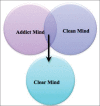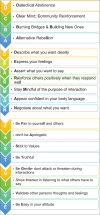A Transdiagnostic Approach to Interventions in Addictive Disorders- Third wave therapies and other current interventions
- PMID: 29540925
- PMCID: PMC5844166
- DOI: 10.4103/psychiatry.IndianJPsychiatry_20_18
A Transdiagnostic Approach to Interventions in Addictive Disorders- Third wave therapies and other current interventions
Abstract
Recent research points to a shift from categorical diagnoses to a dimensional understanding of psychopathology and mental health disorders. In parallel, there has been a rise in newer psychosocial treatment modalities, which are inherently transdiagnostic. Transdiagnostic approaches are those that identify core vulnerabilities and apply universal principles to therapeutic treatment. As treatment of substance use disorders (SUD) must invariably accommodate such vulnerabilities, clinicians are finding such interventions useful. Therapies like Acceptance and Commitment Therapy (ACT), Dialectical Behavioural Therapy (DBT), Metacognitive Therapy, Mindfulness-Based Relapse Prevention (MBRP) use a transdiagnostic framework and are backed by evidence in the last 3-5 years. In this paper we first highlight the conceptual understanding of SUD through these frameworks and then discuss their clinical applications along with specific techniques that have been particularly useful with this population.
Keywords: Acceptance Commitment Therapy; Dialectical behaviour therapy; Schema Therapy; Third wave interventions; dialectical abstinence; radical acceptance.
Conflict of interest statement
There are no conflicts of interest.
Figures









Similar articles
-
Cognitive-behavioral therapies for depression and substance use disorders: An overview of traditional, third-wave, and transdiagnostic approaches.Am J Drug Alcohol Abuse. 2017 Jul;43(4):402-415. doi: 10.1080/00952990.2016.1199697. Epub 2016 Aug 5. Am J Drug Alcohol Abuse. 2017. PMID: 27494547 Review.
-
[The third wave of cognitive-behavioural psychotherapies: concepts and efficacy].Fortschr Neurol Psychiatr. 2011 Jun;79(6):330-9. doi: 10.1055/s-0029-1245963. Epub 2011 Mar 16. Fortschr Neurol Psychiatr. 2011. PMID: 21412690 Review. German.
-
[Mindfulness-based-relapse prevention (MBRP): Evaluation of the impact of a group of Mindfulness Therapy in alcohol relapse prevention for alcohol use disorders].Encephale. 2015 Dec;41(6):521-6. doi: 10.1016/j.encep.2015.05.003. Epub 2015 Jul 6. Encephale. 2015. PMID: 26159682 French.
-
Third-Generation Therapies for the Management of Psychoactive Substance Use in Young People: Scoping Review.Behav Sci (Basel). 2024 Dec 13;14(12):1192. doi: 10.3390/bs14121192. Behav Sci (Basel). 2024. PMID: 39767333 Free PMC article.
-
The third wave of cognitive behavioural therapies: what is new and what is effective?Curr Opin Psychiatry. 2012 Nov;25(6):522-8. doi: 10.1097/YCO.0b013e328358e531. Curr Opin Psychiatry. 2012. PMID: 22992547 Review.
Cited by
-
Emotional self-knowledge profiles and relationships with mental health indicators support value in 'knowing thyself'.Sci Rep. 2024 Apr 4;14(1):7900. doi: 10.1038/s41598-024-57282-w. Sci Rep. 2024. PMID: 38570512 Free PMC article.
-
Gambling disorder in the UK: key research priorities and the urgent need for independent research funding.Lancet Psychiatry. 2022 Apr;9(4):321-329. doi: 10.1016/S2215-0366(21)00356-4. Epub 2022 Feb 15. Lancet Psychiatry. 2022. PMID: 35180386 Free PMC article. Review.
-
Review of Studies Regarding Assessment of Families Where Children Are at Risk of Harm Due to Parental Substance Misuse.Int J Environ Res Public Health. 2025 Apr 14;22(4):612. doi: 10.3390/ijerph22040612. Int J Environ Res Public Health. 2025. PMID: 40283836 Free PMC article. Review.
References
-
- Sauer-Zavala S, Gutner CA, Farchione TJ, Boettcher HT, Bullis JR, Barlow DH. Current definitions of “transdiagnostic” in treatment development: A search for consensus. Behavior therapy. 2017;48(1):128–38. - PubMed
-
- Kahl KG, Winter L, Schweiger U. The third wave of cognitive behavioural therapies: what is new and what is effective? Current opinion in psychiatry. 2012;25(6):522–8. - PubMed
-
- Kotov R, Krueger RF, Watson D, Achenbach TM, Althoff RR, Bagby RM, Brown TA, Carpenter WT, Caspi A, Clark LA, Eaton NR. The Hierarchical Taxonomy of Psychopathology (HiTOP): A dimensional alternative to traditional nosologies. Journal of abnormal psychology. 2017;126(4):454. - PubMed
-
- Lee EB, An W, Levin ME, Twohig MP. An initial meta-analysis of Acceptance and Commitment Therapy for treating substance use disorders. Drug and alcohol dependence. 2015;155:1–7. - PubMed
Publication types
LinkOut - more resources
Full Text Sources
Research Materials

